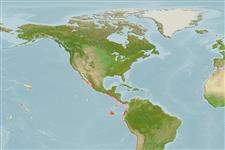Environment: milieu / climate zone / depth range / distribution range
Ökologie
seewasser benthopelagisch; tiefenbereich ? - 650 m (Ref. 34024), usually 40 - 75 m (Ref. 36413). Tropical; 25°N - 6°S
Eastern Central Pacific: Gulf of California to Peru.
Length at first maturity / Size / Gewicht / Alter
Maturity: Lm 75.4 range ? - ? cm
Max length : 115 cm TL Männchen/unbestimmt; (Ref. 55763); common length : 45.0 cm TL Männchen/unbestimmt; (Ref. 55763)
Kurzbeschreibung
Morphologie | Morphometrie
Rückenflossenstacheln (insgesamt): 0; Rückenflossenweichstrahlen (insgesamt): 108-118; Afterflossenstacheln 0; Afterflossenweichstrahlen: 78 - 89; Wirbelzahl: 55 - 56. Body completely covered with small, imbricate, cycloid scales; barbels present on snout (6) and chin (6); branchiostegal rays 8; median basibranchial tooth patch absent; developed gill rakers on first arch 4 or fewer; pelvic fin rays inserted at about level of preopercle, well behind eye (Ref. 34024).
Adults benthopelagic to 650 m depth, juveniles common on reefs (Ref. 34024). At depths of about 40-75 m, adults are found deep on mud and broken shell bottom (Ref. 36413). Smaller silvery specimens taken far out at sea in the epipelagic (Ref. 34024). Caught occasionally (Ref. 34024). Oviparous, with late post-flexion and transformation stage larvae found in midwater (Ref. 36413). Oval, pelagic eggs float in a gelatinous mass (Ref. 205).
Oviparous, with no specialized copulatory organ (Ref. 36413).
Nielsen, J.G., D.M. Cohen, D.F. Markle and C.R. Robins, 1999. Ophidiiform fishes of the world (Order Ophidiiformes). An annotated and illustrated catalogue of pearlfishes, cusk-eels, brotulas and other ophidiiform fishes known to date. FAO Fish. Synop. 125(18):178p. Rome: FAO. (Ref. 34024)
IUCN Rote Liste Status (Ref. 130435)
Bedrohung für Menschen
Harmless
Nutzung durch Menschen
Fischereien: weniger kommerziell
Mehr Information
ReferenzenAquakulturAquakultur ProfilZuchtlinienGenetikElectrophoresesVererbbarkeitKrankheitenVerarbeitungNutrientsMass conversion
Tools
Zusatzinformationen
Download XML
Internet Quellen
Estimates based on models
Preferred temperature (Ref.
123201): 16 - 25.2, mean 19.4 °C (based on 24 cells).
Phylogenetic diversity index (Ref.
82804): PD
50 = 0.5156 [Uniqueness, from 0.5 = low to 2.0 = high].
Bayesian length-weight: a=0.00380 (0.00200 - 0.00722), b=3.12 (2.94 - 3.30), in cm total length, based on LWR estimates for this species & (Sub)family-body (Ref.
93245).
Trophic level (Ref.
69278): 4.1 ±0.77 se; based on food items.
Widerstandsfähigkeit (Ref.
120179): mittel, Verdopplung der Population dauert 1,4 - 4,4 Jahre. (Preliminary K or Fecundity.).
Prior r = 0.38, 95% CL = 0.25 - 0.57, Based on 1 stock assessment.
Fishing Vulnerability (Ref.
59153): Moderate to high vulnerability (45 of 100).
Nutrients (Ref.
124155): Calcium = 56.5 [31.2, 137.3] mg/100g; Iron = 0.759 [0.396, 1.366] mg/100g; Protein = 16.2 [13.7, 18.7] %; Omega3 = 0.202 [0.105, 0.413] g/100g; Selenium = 151 [68, 350] μg/100g; VitaminA = 11.9 [3.5, 39.7] μg/100g; Zinc = 0.728 [0.481, 1.126] mg/100g (wet weight);
